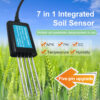Introduction
As the global population continues to grow, the demand for food production is increasing at an unprecedented rate. However, traditional farming practices often lead to environmental degradation, including soil erosion, water pollution, and greenhouse gas emissions. To address these challenges, sustainable farming practices have gained significant attention in recent years. One crucial aspect of sustainable farming is the efficient use of resources, such as water and fertilizers, which can be achieved through the use of soil sensors. This article explores the role of soil sensors in sustainable farming practices and discusses their benefits and challenges.

What are Soil Sensors?
Soil sensors are devices that are used to measure various soil properties, including moisture content, temperature, and nutrient levels. These sensors provide real-time data that can help farmers make informed decisions about irrigation, fertilization, and other farming practices. Soil sensors can be placed at different depths in the soil, allowing farmers to monitor changes in soil conditions over time.
Benefits of Soil Sensors in Sustainable Farming
Efficient Water Management: Water scarcity is a significant challenge in many agricultural regions. By using soil sensors to measure soil moisture levels, farmers can determine when and how much water to apply to their crops. This allows for precise irrigation, reducing water waste and increasing water use efficiency.
Optimized Fertilizer Application: Overuse of fertilizers not only leads to environmental pollution but also increases production costs for farmers. Soil sensors can provide accurate information about nutrient levels in the soil, enabling farmers to apply fertilizers only when and where they are needed. This reduces fertilizer waste and improves nutrient uptake by plants, leading to higher crop yields.
Improved Crop Health: Soil sensors can also help farmers monitor soil temperature and pH levels, which are crucial factors for plant growth. By maintaining optimal soil conditions, farmers can prevent crop diseases and optimize plant growth, leading to healthier and more productive crops.
Reduced Environmental Impact: Sustainable farming practices aim to minimize the negative environmental impacts of agriculture. By using soil sensors to precisely manage water and fertilizer applications, farmers can reduce nutrient runoff and groundwater contamination. This, in turn, helps to protect water quality and preserve ecosystems.

Challenges and Limitations
While soil sensors offer numerous benefits, there are also challenges and limitations associated with their use in sustainable farming practices.
Cost: Soil sensors can be expensive, especially for small-scale farmers. The initial investment cost and maintenance expenses may deter some farmers from adopting this technology.
Data Interpretation: Soil sensor data needs to be accurately interpreted to make informed decisions. Farmers may require training or technical support to effectively use the data provided by soil sensors.
Calibration and Accuracy: Soil sensors need to be properly calibrated to provide accurate readings. Calibration can be time-consuming and requires expertise to ensure reliable measurements.
Integration with Farming Systems: Integrating soil sensors into existing farming systems can be challenging. Farmers may need to modify their irrigation and fertilization practices to effectively utilize the data provided by soil sensors.
Conclusion
Soil sensors play a crucial role in sustainable farming practices by enabling efficient resource management and reducing environmental impacts. By providing real-time data on soil moisture, temperature, and nutrient levels, soil sensors help farmers optimize irrigation and fertilization practices, leading to increased water and nutrient use efficiency. However, the adoption of soil sensors in agriculture faces challenges related to cost, data interpretation, calibration, and integration with existing farming systems. Overcoming these challenges and promoting the widespread use of soil sensors can contribute to the development of sustainable agriculture, ensuring food security while protecting the environment.